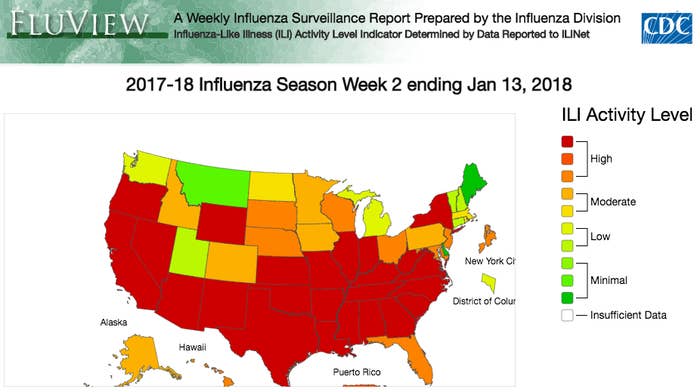
Despite the government shutdown, the Centers for Disease Control and Prevention said it will continue its flu program, which helps track in real-time how this unusually severe flu season is changing across the country.
Hours before a failed congressional vote caused all manner of “nonessential” federal programs to shudder to a halt, a contingency plan said the CDC’s “immediate response to urgent disease outbreaks, including seasonal influenza, would continue” under a shutdown.
What’s more, the plan said that in order “to continue ongoing influenza surveillance, the CDC would collect data being reported by states, hospitals, and others.”
“These sentences would make it appear — and I think it’s a good decision — that influenza surveillance would continue,” William Schaffner, an infectious disease specialist at Vanderbilt University Medical Center, told BuzzFeed News right after the shutdown began. He leads one of several labs across the country that analyze samples from hospitalized flu patients and feed their findings to the CDC, which in turn compiles national snapshots of the flu season.
“Should an unusual strain appear,” he added, “that would be a matter of definite public health urgency and need and very careful investigation. You can’t find that out unless you have incoming information from the surveillance sites into the CDC.”
The CDC’s flu program issues weekly reports about how the flu season is progressing, with tallies of national and regional cases of the illness and the types of strains going around, as well as hospitalizations and deaths. This season has been particularly bad: In its latest report on Friday, the CDC said that in the week ending Jan. 13, the virus had killed 10 children, bringing the total number of kids’ deaths for the season to 30.

Schaffner and other public health experts had feared these reports would stop, based on an earlier version of the contingency plan, which said that a shutdown would leave the CDC “unable to support the annual seasonal influenza program.” News reports this week had also warned that the shutdown could stop flu tracking.
And a suspension wouldn’t have been unprecedented. The CDC furloughed the employees in charge of its flu-tracking efforts during the last shutdown, which spanned 16 days in October 2013, toward the beginning of that flu season.
A CDC spokesperson told BuzzFeed News late Friday that the flu reports might be issued more slowly than usual.
“Under a shutdown, CDC’s capacity to track and respond to disease outbreaks will be impacted,” the spokesperson said. “Flu surveillance, for example, will continue to collect data being reported by states, hospitals, etc. However, our staff resources are limited, which means it will take longer to review, analyze, and report out information needed for public health action.”
Local, county, and state health departments do a lot of flu monitoring, and patients aren't treated by the federal government, noted Arthur Reingold, an epidemiologist at the University of California, Berkeley. “I anticipate no real problem re: tracking flu for the foreseeable future,” he told BuzzFeed News by email.
As for monitoring diseases besides the flu, the contingency plan noted that CDC's cut-back staff will also be slower to provide updates about nonurgent outbreaks. Similarly, the agency said it wouldn’t be able to run most programs for preventing noncommunicable diseases.
Schaffner said this means reporting would be delayed for foodborne, fungal, and other diseases, unless one were to rise to the level of an outbreak.
